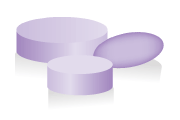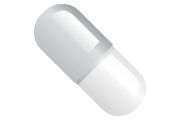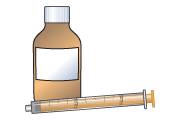Gabapentin for dystonia
This leaflet is for parents and carers about how to use this medicine in children. Our information may differ from that provided by the manufacturers, because their information usually relates to adults. Read this leaflet carefully. Keep it somewhere safe so that you can read it again.
Do not stop giving Gabapentin suddenly, as your child is likely to get withdrawal symptoms
Name of medicine
Gabapentin
Brand name: Neurontin
Why is it important for my child to take Gabapentin?
Children with dystonia can get painful and distressing movements and muscle spams, which may make movement and muscle spasms, which may make movement, sitting and standing difficult. Gabapentin acts in the brain to slow down messages to the muscles and nerves. This reduces muscle stiffness and improves comfort.
What is Gabapentin available as?
- Tablets: 600 mg, 800 mg
- Capsules: 100 mg, 300 mg, 400 mg; these contain small amounts of lactose
- Liquid medicine: 50 mg in 1 mL; these may contain acesulfame K, saccharin sodium (artificial sweeteners) and propylene glycol
When should I give Gabapentin
Gabapentin is usually given three times each day. These should be evenly spaced, usually 6 hours apart. For example, between 7 am and 8 am, between 1 pm and 2 pm, and between 7 pm and 8 pm.
- Your doctor may suggest that you start by giving Gabapentin once a day for a few days, then twice a day for a few days, and then three times a day. This will help your child to get used to the medicine. Your doctor will explain what to do.
- When you give it once a day, this can be in the morning or the evening.
- When you give it twice a day, this should be in the morning and in the evening. Ideally these times are 10–12 hours apart. For example, this could be between 7 and 8 am and between 7 and 8 pm.
Give the medicine at about the same time(s) each day so that this becomes part of your child’s daily routine, which will help you to remember.
It is important that you follow your doctor’s instructions.
How much should I give?
Your doctor will work out the amount of Gabapentin (the dose) that is right for your child. The dose will be shown on the medicine label.
Your doctor may suggest that your child starts with a low dose. They may then increase the dose as your child gets used to the medicine and depending on how they respond to it. Your doctor will explain what to do. If you are not sure how much to give, check with your doctor, nurse or pharmacist.
How should I give Gabapentin?

Tablets
- Tablets should be swallowed with a glass of water, squash or juice. Your child should not chew the tablet.

Capsules
- Capsules should be swallowed with a glass of water, squash or juice. Your child should not chew the capsule.

Liquid medicine
Measure out the right amount using a medicine spoon or oral syringe. You can get these from your pharmacist. Do not use a kitchen teaspoon as it will not give the right amount.
When should the medicine start working?
It may take a few days or even weeks for Gabapentin to work properly, so your child may still have their symptoms for a while. This is because the amount of medicine has to be increased slowly. Continue to give the medicine as you have been told to by your doctor.
What if my child is sick (vomits)?
- If your child is sick less than 30 minutes after having a dose of Gabapentin, give them the same dose again.
- If your child is sick more than 30 minutes after having a dose of Gabapentin, do not give them another dose. Wait until the next normal dose.
If your child is sick again, seek advice from your family doctor, nurse, pharmacist, or hospital. They will decide what to do based on your child’s condition and the specific medicine involved.
What if I forget to give it?
If you usually give it once a day in the morning: Give the missed dose when you remember during the day, as long as this is at least 12 hours before the next dose is due.
If you usually give it once a day in the evening: If you remember before bedtime, give the missed dose. You do not need to wake a sleeping child to give a missed dose. You can give the missed dose in the morning, as long as this is at least 12 hours before the evening dose is due.
If you usually give it twice a day: If you remember up to 4 hours after you should have given a dose, give your child the missed dose. For example, if you usually give a dose at about 7am, you can give the missed dose at any time up to 11am. If you remember after that time, do not give the missed dose. Give the next dose as usual.
If you usually give it three times a day: Do not give the missed dose. Just give the next dose as usual.
What if I give too much?
If you think you may have given your child too much Gabapentin, contact your doctor or local NHS services (details at end of leaflet) or take your child to hospital. Have the medicine container or packaging with you, even if it is empty. This will be useful to the doctor.
Are there any possible side effects?
We use medicines to make our children better but sometimes they cause effects that we don’t want (side-effects).
Your child may get the following side-effects when they first start taking gabapentin. These usually settle down within a week or so as their body gets used to the medicine. Continue to give gabapentin as your doctor has told you to during this time. If any of these side-effects continue for longer than a week, or you are worried, contact your doctor.
- Your child may be drowsy (sleepy), dizzy or unsteady.
- Your child may feel less hungry (lose their appetite), and feel sick (nausea) or be sick (vomit).
- Your child may get diarrhoea, constipation, wind, indigestion or a dry mouth. Your doctor may be able to prescribe other medicines to help with these symptoms.
- Occasionally children may seem emotional, anxious or overactive or may have problems with their memory.
- Your child may be hungrier than usual – this can last for many months. Encourage your child to eat food that is low in fat and sugar, otherwise they may put on weight.
Your child may sometimes get side-effects that are not listed above. If you notice anything unusual and are concerned, contact your doctor. You can report any suspected side-effects to the UK safety scheme at mhra.gov.uk/yellowcard.
More information on side-effects can be found in a leaflet on our website.
Can other medicines be given at the same time as Gabapentin?
- You can give your child medicines that contain paracetamol or ibuprofen, unless your doctor has told you not to.
- The Gabapentin should not be taken with some common drugs that you get on prescription. It is important to tell your doctor and pharmacist that your child is taking Gabapentin.
Gabapentin should not be taken with some medicines that you get on prescription. Tell your doctor and pharmacist about any other medicines your child is taking before giving Gabapentin. This includes herbal and complementary medicines.
Is there anything else I need to know about this medicine?
Do not suddenly stop giving Gabapentin to your child, as they may get withdrawal symptoms.
Gabapentin is also used to treat neuropathic pain and epilepsy (seizures), if you look for information on gabapentin, make sure it relates to dystonia, as different doses may be used for different conditions.
General advice about medicines
- Try to give medicines at about the same times each day, to help you remember.
- If you are not sure a medicine is working, contact your doctor but continue to give the medicine as usual in the meantime. Do not give extra doses, as you may do harm.
- Only give this medicine to your child. Never give it to anyone else, even if their condition appears to be the same, as this could do harm.
- If you think someone else may have taken the medicine, contact a doctor straight away.
- Make sure that you always have enough medicine. Order a new prescription at least 2 weeks before you will run out.
- Make sure that the medicines you have at home have not reached the ‘use by’ date on the packaging. Give old medicines to your pharmacist to dispose of.
Where should I keep this medicine?
- Keep the medicine in a cupboard, away from heat and direct sunlight. It does not need to be kept in the fridge.
- Make sure that children cannot see or reach the medicine.
- Keep the medicine in the container and packaging it came in.
Who to contact for more information?
Your doctor, pharmacist or nurse will be able to give you more information about Gabapentin and about other medicines used to treat dystonia.
England: NHS 111
Tel 111
www.nhs.ukScotland: NHS 24
Tel 111
www.nhs24.scotNorthern Ireland: NI Direct
Wales: NHS 111 Wales
Tel 111
www.111.wales.nhs.ukDystonia UK
020 7793 3651
www.dystonia.org.uk/Copyright disclaimer
Version [1]. © NPPG, RCPCH and WellChild, all rights reserved. Review by January 2028.
The primary source for the information in this leaflet is the British National Formulary for Children. For details on any other sources used for this leaflet, please contact us through our website, www.medicinesforchildren.org.uk.
We take great care to make sure that the information in this leaflet is correct and up-to-date. However, medicines can be used in different ways for different patients. It is important that you ask the advice of your doctor or pharmacist if you are not sure about something. This leaflet is about the use of these medicines in the UK, and may not apply to other countries. The Royal College of Paediatrics and Child Health (RCPCH), the Neonatal and Paediatric Pharmacists Group (NPPG), WellChild and the contributors and editors cannot be held responsible for the accuracy of information, omissions of information, or any actions that may be taken as a consequence of reading this leaflet.
